Abstract
While expression of complement receptor 2 (CR2) (CD21) on some CD4+ cell lines renders them more susceptible to infection by complement-treated human immunodeficiency virus (HIV), coexpression of CR2 and CD4 on peripheral blood lymphocytes has not, until recently, been observed. Several recent studies, however, have found that human T lymphocytes express low levels of CR2. Additionally, complement treatment of HIV before addition to these cells has been reported to increase virus expression in peripheral blood lymphocyte cultures. These findings suggest that complement-mediated enhancement of infection of human T cells could occur in vivo and have prompted us to examine both the phenotypic properties of CD4+CR2+ T cells in healthy persons and the expression of CR2 on CD4+ lymphocytes during HIV infection. As was previously reported, we observed CR2 on a proportion (10-50%) of both CD8+ and CD4+ T cells. Approximately half of CD4+CR2+ cells expressed the memory cell markers CD45RO and CD29, 80% expressed the naive marker CD45RA, while 22% expressed CD25. These values were not substantially different from total CD4+ cells. Stimulation of lymphocytes with phytohaemagglutinin (PHA), OKT3 or calcium ionophore but not with phorbol myristate acetate (PMA) or interleukin-2 (IL-2) decreased expression of CR2 on CD4 cells by half over a 3-day culture period. The per cent of CD4+ cells expressing CR2 was significantly decreased in patients with asymptomatic and symptomatic HIV infection compared to uninfected control donors (P = 0.0001). In contrast, the decrease in CR2 expression was not observed with CD8+ lymphocytes from HIV-infected persons. These results confirm that CR2 is expressed on human T lymphocytes and suggest that a subset of CD4+ lymphocytes is selectively affected in HIV-infected individuals.
Full text
PDF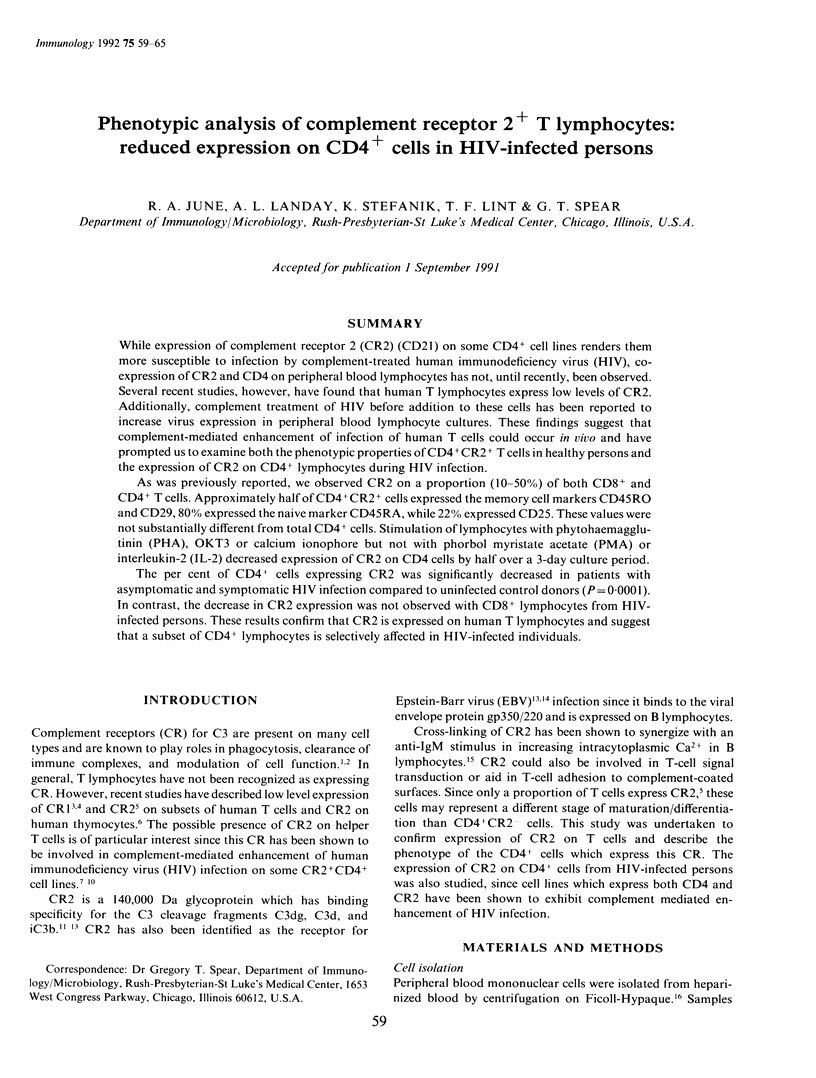
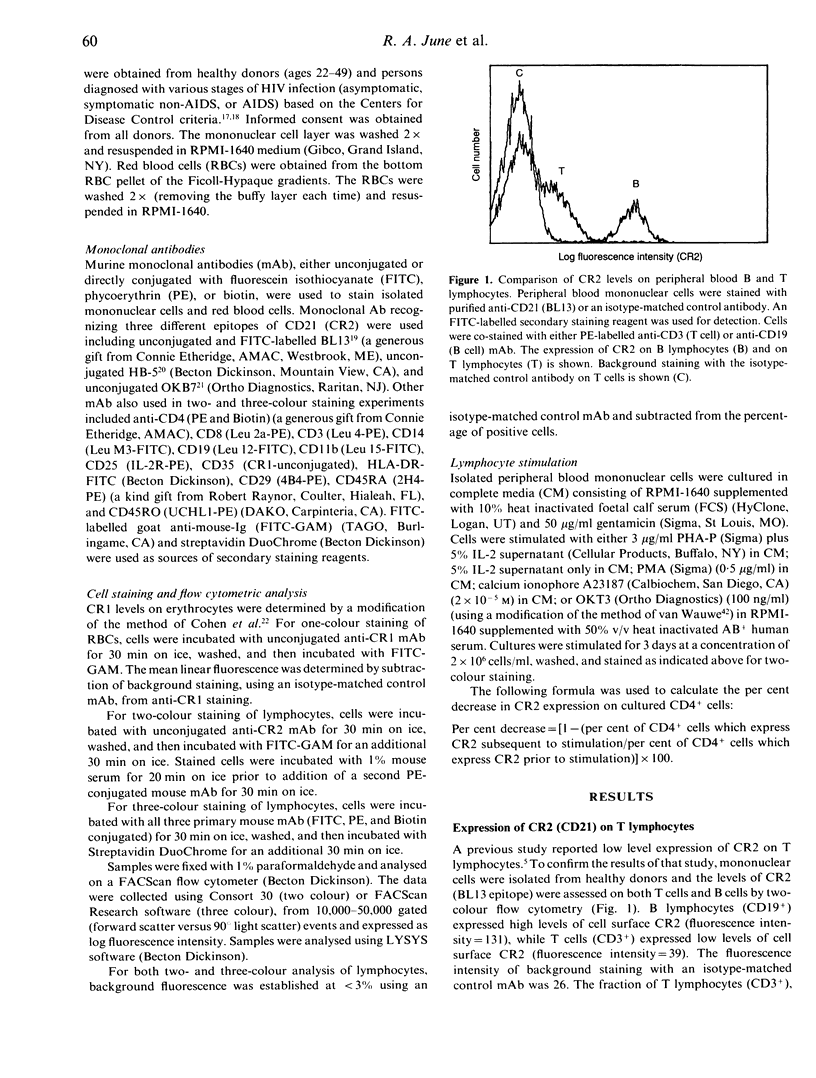
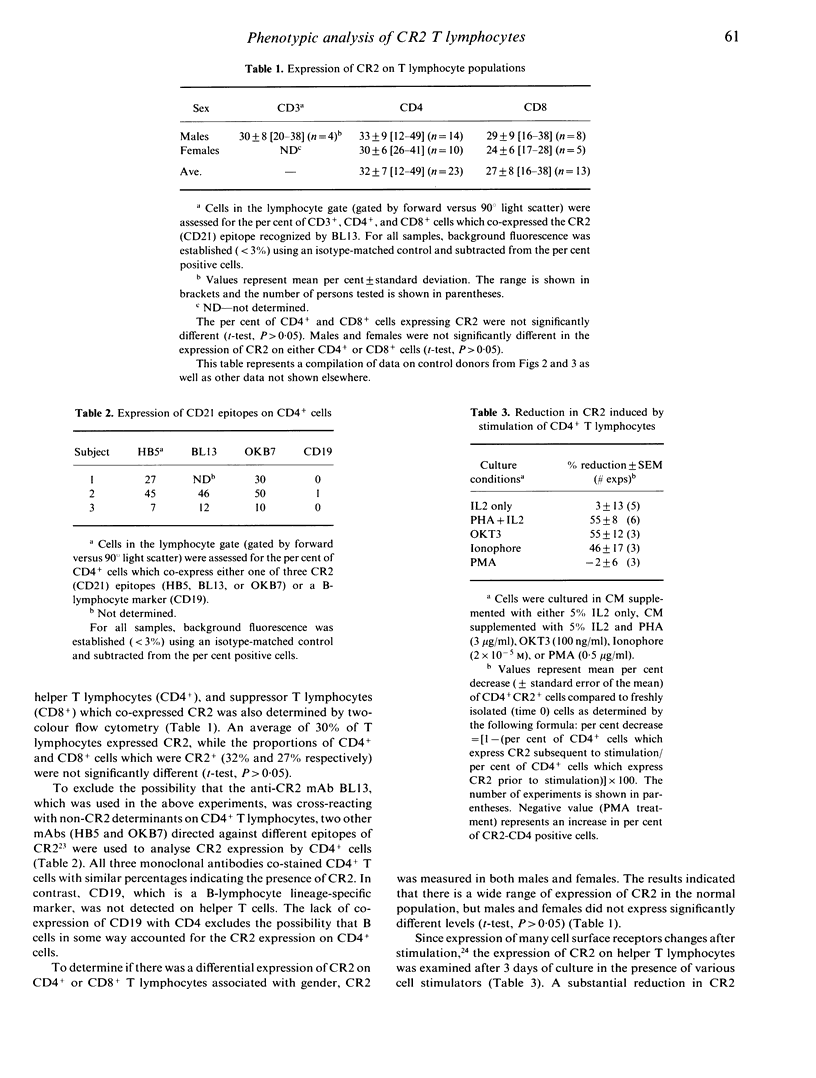
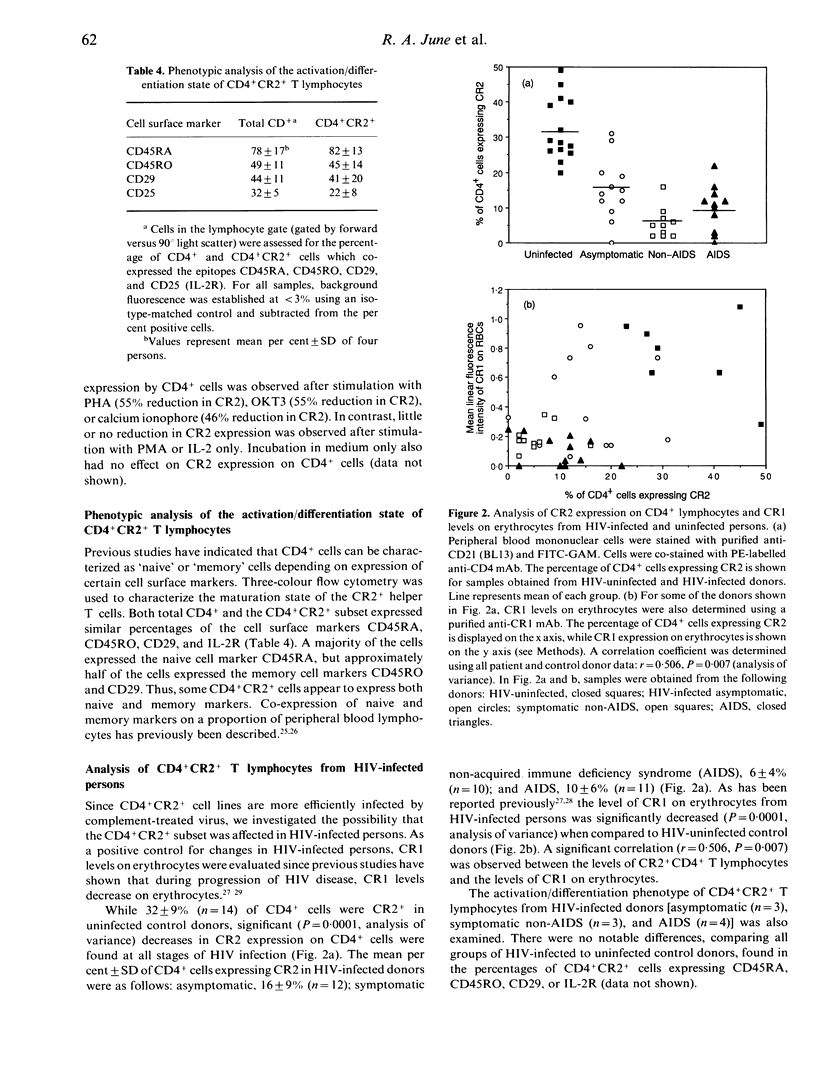
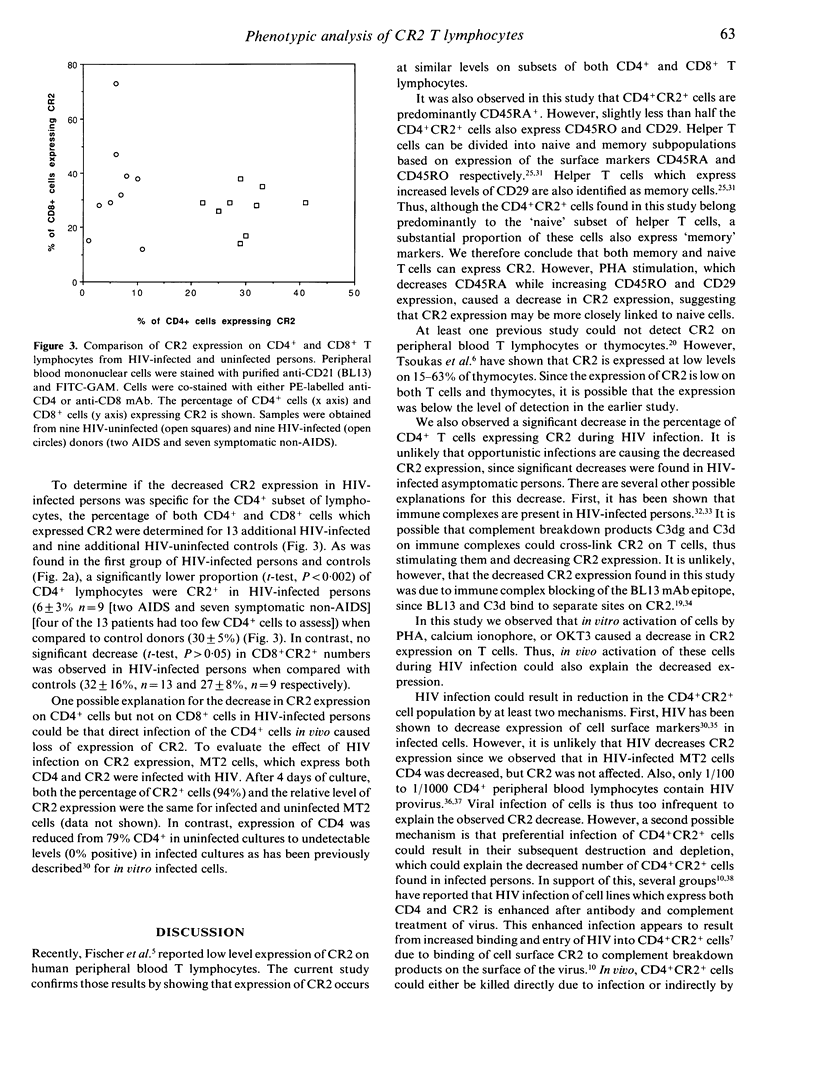
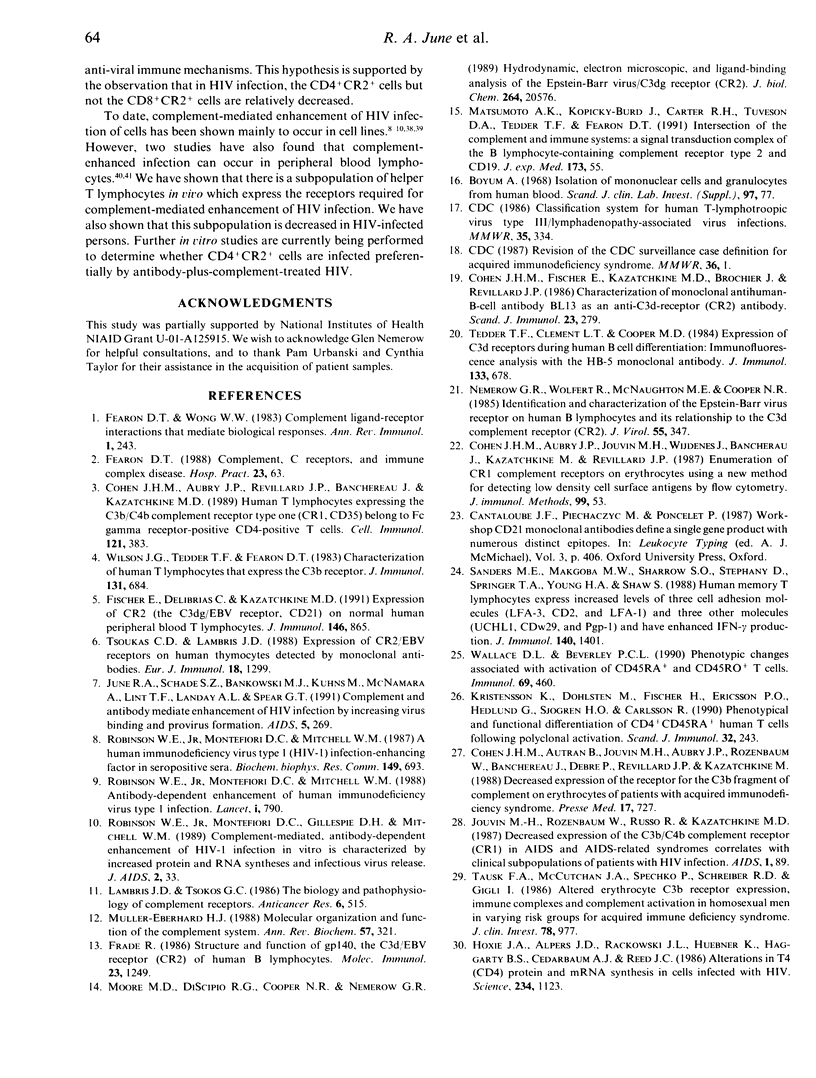
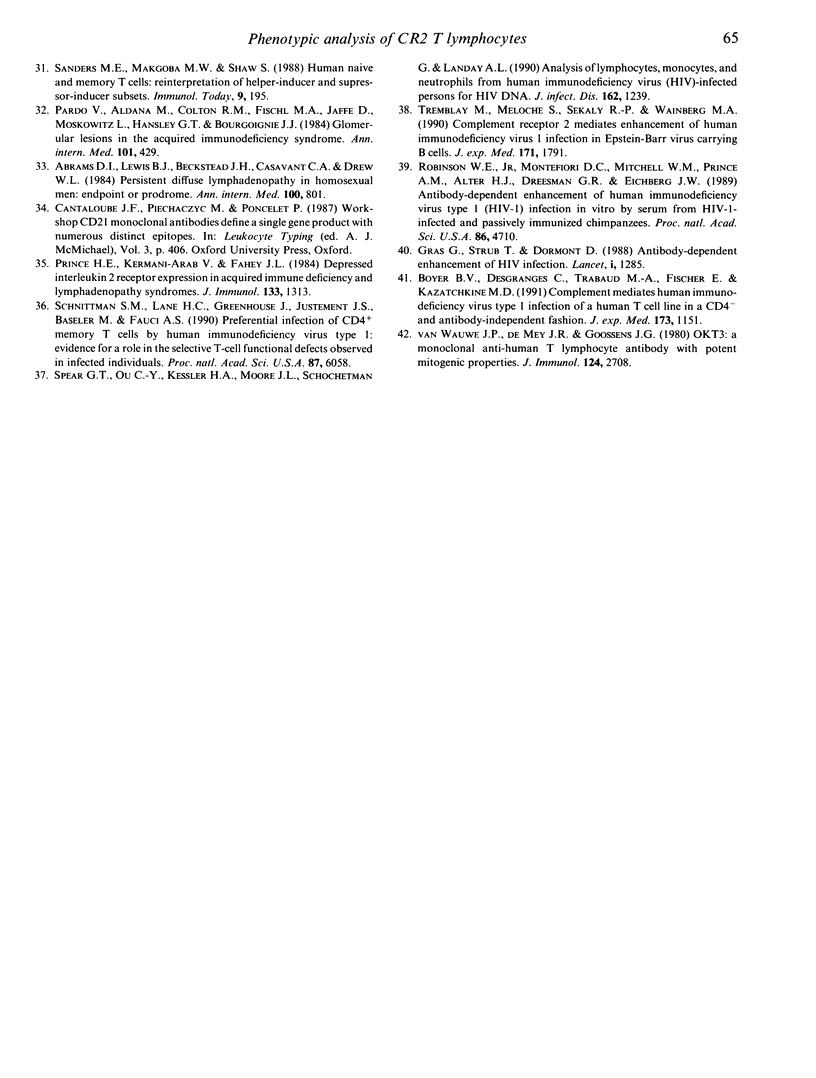
Selected References
These references are in PubMed. This may not be the complete list of references from this article.
- Abrams D. I., Lewis B. J., Beckstead J. H., Casavant C. A., Drew W. L. Persistent diffuse lymphadenopathy in homosexual men: endpoint or prodrome? Ann Intern Med. 1984 Jun;100(6):801–808. doi: 10.7326/0003-4819-100-6-801. [DOI] [PubMed] [Google Scholar]
- Antibody-dependent enhancement of HIV infection. Lancet. 1988 Jun 4;1(8597):1285–1286. [PubMed] [Google Scholar]
- Boyer V., Desgranges C., Trabaud M. A., Fischer E., Kazatchkine M. D. Complement mediates human immunodeficiency virus type 1 infection of a human T cell line in a CD4- and antibody-independent fashion. J Exp Med. 1991 May 1;173(5):1151–1158. doi: 10.1084/jem.173.5.1151. [DOI] [PMC free article] [PubMed] [Google Scholar]
- Böyum A. Isolation of mononuclear cells and granulocytes from human blood. Isolation of monuclear cells by one centrifugation, and of granulocytes by combining centrifugation and sedimentation at 1 g. Scand J Clin Lab Invest Suppl. 1968;97:77–89. [PubMed] [Google Scholar]
- Cohen J. H., Aubry J. P., Jouvin M. H., Wijdenes J., Bancherau J., Kazatchkine M., Revillard J. P. Enumeration of CR1 complement receptors on erythrocytes using a new method for detecting low density cell surface antigens by flow cytometry. J Immunol Methods. 1987 May 4;99(1):53–58. doi: 10.1016/0022-1759(87)90031-7. [DOI] [PubMed] [Google Scholar]
- Cohen J. H., Aubry J. P., Revillard J. P., Banchereau J., Kazatchkine M. D. Human T lymphocytes expressing the C3b/C4b complement receptor type one (CR1, CD35) belong to Fc gamma receptor-positive CD4-positive T cells. Cell Immunol. 1989 Jul;121(2):383–390. doi: 10.1016/0008-8749(89)90037-3. [DOI] [PubMed] [Google Scholar]
- Cohen J. H., Autran B., Jouvin M. H., Aubry J. P., Rozenbaum W., Banchereau J., Debré P., Revillard J. P., Kazatchkine M. Diminution des récepteurs érythrocytaires pour le fragment C3b du complément dans le syndrome d'immunodéficience acquise. Presse Med. 1988 Apr 23;17(15):727–730. [PubMed] [Google Scholar]
- Cohen J. H., Fischer E., Kazatchkine M. D., Brochier J., Revillard J. P. Characterization of monoclonal antihuman-B-cell antibody BL13 as an anti-C3d-receptor (CR2) antibody. Scand J Immunol. 1986 Mar;23(3):279–285. doi: 10.1111/j.1365-3083.1986.tb01969.x. [DOI] [PubMed] [Google Scholar]
- Fearon D. T. Complement, C receptors, and immune complex disease. Hosp Pract (Off Ed) 1988 Aug 15;23(8):63–72. doi: 10.1080/21548331.1988.11703520. [DOI] [PubMed] [Google Scholar]
- Fearon D. T., Wong W. W. Complement ligand-receptor interactions that mediate biological responses. Annu Rev Immunol. 1983;1:243–271. doi: 10.1146/annurev.iy.01.040183.001331. [DOI] [PubMed] [Google Scholar]
- Fischer E., Delibrias C., Kazatchkine M. D. Expression of CR2 (the C3dg/EBV receptor, CD21) on normal human peripheral blood T lymphocytes. J Immunol. 1991 Feb 1;146(3):865–869. [PubMed] [Google Scholar]
- Frade R. Structure and functions of gp 140, the C3d/EBV receptor (CR2) of human B lymphocytes. Mol Immunol. 1986 Nov;23(11):1249–1253. doi: 10.1016/0161-5890(86)90159-8. [DOI] [PubMed] [Google Scholar]
- Hoxie J. A., Alpers J. D., Rackowski J. L., Huebner K., Haggarty B. S., Cedarbaum A. J., Reed J. C. Alterations in T4 (CD4) protein and mRNA synthesis in cells infected with HIV. Science. 1986 Nov 28;234(4780):1123–1127. doi: 10.1126/science.3095925. [DOI] [PubMed] [Google Scholar]
- June R. A., Schade S. Z., Bankowski M. J., Kuhns M., McNamara A., Lint T. F., Landay A. L., Spear G. T. Complement and antibody mediate enhancement of HIV infection by increasing virus binding and provirus formation. AIDS. 1991 Mar;5(3):269–274. doi: 10.1097/00002030-199103000-00004. [DOI] [PubMed] [Google Scholar]
- Kristensson K., Dohlsten M., Fischer H., Ericsson P. O., Hedlund G., Sjögren H. O., Carlsson R. Phenotypical and functional differentiation of CD4+ CD45RA+ human T cells following polyclonal activation. Scand J Immunol. 1990 Sep;32(3):243–253. doi: 10.1111/j.1365-3083.1990.tb02917.x. [DOI] [PubMed] [Google Scholar]
- Matsumoto A. K., Kopicky-Burd J., Carter R. H., Tuveson D. A., Tedder T. F., Fearon D. T. Intersection of the complement and immune systems: a signal transduction complex of the B lymphocyte-containing complement receptor type 2 and CD19. J Exp Med. 1991 Jan 1;173(1):55–64. doi: 10.1084/jem.173.1.55. [DOI] [PMC free article] [PubMed] [Google Scholar]
- Moore M. D., DiScipio R. G., Cooper N. R., Nemerow G. R. Hydrodynamic, electron microscopic, and ligand-binding analysis of the Epstein-Barr virus/C3dg receptor (CR2). J Biol Chem. 1989 Dec 5;264(34):20576–20582. [PubMed] [Google Scholar]
- Müller-Eberhard H. J. Molecular organization and function of the complement system. Annu Rev Biochem. 1988;57:321–347. doi: 10.1146/annurev.bi.57.070188.001541. [DOI] [PubMed] [Google Scholar]
- Nemerow G. R., Wolfert R., McNaughton M. E., Cooper N. R. Identification and characterization of the Epstein-Barr virus receptor on human B lymphocytes and its relationship to the C3d complement receptor (CR2). J Virol. 1985 Aug;55(2):347–351. doi: 10.1128/jvi.55.2.347-351.1985. [DOI] [PMC free article] [PubMed] [Google Scholar]
- Pardo V., Aldana M., Colton R. M., Fischl M. A., Jaffe D., Moskowitz L., Hensley G. T., Bourgoignie J. J. Glomerular lesions in the acquired immunodeficiency syndrome. Ann Intern Med. 1984 Oct;101(4):429–434. doi: 10.7326/0003-4819-101-4-429. [DOI] [PubMed] [Google Scholar]
- Prince H. E., Kermani-Arab V., Fahey J. L. Depressed interleukin 2 receptor expression in acquired immune deficiency and lymphadenopathy syndromes. J Immunol. 1984 Sep;133(3):1313–1317. [PubMed] [Google Scholar]
- Robinson W. E., Jr, Montefiori D. C., Mitchell W. M. A human immunodeficiency virus type 1 (HIV-1) infection-enhancing factor in seropositive sera. Biochem Biophys Res Commun. 1987 Dec 16;149(2):693–699. doi: 10.1016/0006-291x(87)90423-2. [DOI] [PubMed] [Google Scholar]
- Robinson W. E., Jr, Montefiori D. C., Mitchell W. M. Antibody-dependent enhancement of human immunodeficiency virus type 1 infection. Lancet. 1988 Apr 9;1(8589):790–794. doi: 10.1016/s0140-6736(88)91657-1. [DOI] [PubMed] [Google Scholar]
- Robinson W. E., Jr, Montefiori D. C., Mitchell W. M., Prince A. M., Alter H. J., Dreesman G. R., Eichberg J. W. Antibody-dependent enhancement of human immunodeficiency virus type 1 (HIV-1) infection in vitro by serum from HIV-1-infected and passively immunized chimpanzees. Proc Natl Acad Sci U S A. 1989 Jun;86(12):4710–4714. doi: 10.1073/pnas.86.12.4710. [DOI] [PMC free article] [PubMed] [Google Scholar]
- Sanders M. E., Makgoba M. W., Sharrow S. O., Stephany D., Springer T. A., Young H. A., Shaw S. Human memory T lymphocytes express increased levels of three cell adhesion molecules (LFA-3, CD2, and LFA-1) and three other molecules (UCHL1, CDw29, and Pgp-1) and have enhanced IFN-gamma production. J Immunol. 1988 Mar 1;140(5):1401–1407. [PubMed] [Google Scholar]
- Sanders M. E., Makgoba M. W., Shaw S. Human naive and memory T cells: reinterpretation of helper-inducer and suppressor-inducer subsets. Immunol Today. 1988 Jul-Aug;9(7-8):195–199. doi: 10.1016/0167-5699(88)91212-1. [DOI] [PubMed] [Google Scholar]
- Schnittman S. M., Lane H. C., Greenhouse J., Justement J. S., Baseler M., Fauci A. S. Preferential infection of CD4+ memory T cells by human immunodeficiency virus type 1: evidence for a role in the selective T-cell functional defects observed in infected individuals. Proc Natl Acad Sci U S A. 1990 Aug;87(16):6058–6062. doi: 10.1073/pnas.87.16.6058. [DOI] [PMC free article] [PubMed] [Google Scholar]
- Spear G. T., Ou C. Y., Kessler H. A., Moore J. L., Schochetman G., Landay A. L. Analysis of lymphocytes, monocytes, and neutrophils from human immunodeficiency virus (HIV)-infected persons for HIV DNA. J Infect Dis. 1990 Dec;162(6):1239–1244. doi: 10.1093/infdis/162.6.1239. [DOI] [PubMed] [Google Scholar]
- Tausk F. A., McCutchan A., Spechko P., Schreiber R. D., Gigli I. Altered erythrocyte C3b receptor expression, immune complexes, and complement activation in homosexual men in varying risk groups for acquired immune deficiency syndrome. J Clin Invest. 1986 Oct;78(4):977–982. doi: 10.1172/JCI112688. [DOI] [PMC free article] [PubMed] [Google Scholar]
- Tedder T. F., Clement L. T., Cooper M. D. Expression of C3d receptors during human B cell differentiation: immunofluorescence analysis with the HB-5 monoclonal antibody. J Immunol. 1984 Aug;133(2):678–683. [PubMed] [Google Scholar]
- Tremblay M., Meloche S., Sekaly R. P., Wainberg M. A. Complement receptor 2 mediates enhancement of human immunodeficiency virus 1 infection in Epstein-Barr virus-carrying B cells. J Exp Med. 1990 May 1;171(5):1791–1796. doi: 10.1084/jem.171.5.1791. [DOI] [PMC free article] [PubMed] [Google Scholar]
- Tsoukas C. D., Lambris J. D. Expression of CR2/EBV receptors on human thymocytes detected by monoclonal antibodies. Eur J Immunol. 1988 Aug;18(8):1299–1302. doi: 10.1002/eji.1830180823. [DOI] [PubMed] [Google Scholar]
- Van Wauwe J. P., De Mey J. R., Goossens J. G. OKT3: a monoclonal anti-human T lymphocyte antibody with potent mitogenic properties. J Immunol. 1980 Jun;124(6):2708–2713. [PubMed] [Google Scholar]
- Wallace D. L., Beverley P. C. Phenotypic changes associated with activation of CD45RA+ and CD45RO+ T cells. Immunology. 1990 Mar;69(3):460–467. [PMC free article] [PubMed] [Google Scholar]
- Wilson J. G., Tedder T. F., Fearon D. T. Characterization of human T lymphocytes that express the C3b receptor. J Immunol. 1983 Aug;131(2):684–689. [PubMed] [Google Scholar]


